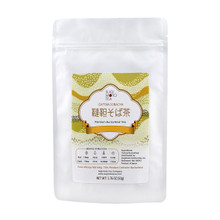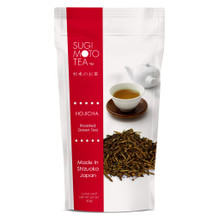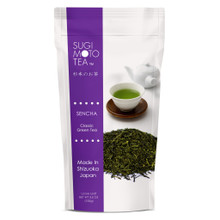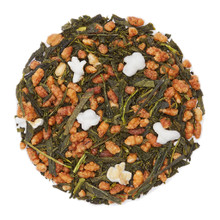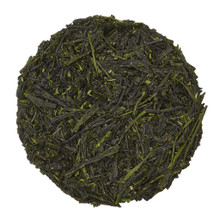Kuchikiri no Chaji
The Japanese tea ceremony, known in Japan as sadō/chadō (茶道), has been an important part of tea culture for centuries. Two types of gathering are considered to fall under the sadō umbrella, chakai (茶会) and chaji (茶事). Chakai is an informal ceremony with either family and friends or a public event where tea and light snacks are served, similar to afternoon tea in the UK. If you have ever been to a tea ceremony at a Japanese garden, it was probably closer to this type of ceremony.
Chaji, however, are formal and full-length gatherings. They often coincide with special occasions or seasonal events. During a chaji, guests will be served an assortment of small Japanese dishes known as kaiseki (懐石) as well as two different kinds of matcha, a thicker one known as koicha (濃茶) and a thinner one known as usucha (薄茶). Frequently, a selection of Japanese sweets known as wagashi are also served to guests. If you’d like to learn more about the types of tea ceremony and their history, we have a full guide available on our blog(Part 1, Part 2).
Today, however, we’d like to introduce you to an important seasonal tea ceremony known as kuchikiri no chaji (口切りの茶事). Held in November, kuchikiri no chaji is an event held in the tea ceremony community to celebrate the new year and is sometimes known as the “tea new year” or ocha no shogatsu (お茶の正月). The ceremony centers around tencha from the first harvest that is sealed into a chatsubo (茶壷), or tea jar, that is then preserved for six months. “Kuchikiri” literally translates to “cutting the mouth” and refers to the seal of the chatsubo being cut before the shincha preserved inside is presented to guests.
Kuchikiri no chaji was traditionally performed on the tenth day of the tenth month, but now simply takes place within the month of November. The guests are greeted at the start of the ceremony by the host when they enter chashitsu, or tea room. Upon entering, guests observe the alcove, known as the tokonoma (床の間), where a scroll and the furnace and kettle used in the ceremony have been placed. They also take in the carefully selected decorations around the room as they get settled. Once the ceremony starts, the host removes the chatsubo from the net of red string that’s unique to each school of the tea ceremony. After the net has been removed, the chatsubo is displayed in the alcove for guests to appreciate.
Next, the host reads from ochairinikki (御茶入日記) which is a tea diary that contains notes about the tea in the chatsubo. They introduce the guests to the tea they’re about to experience before cutting the seal and removing the tencha from inside. After the tencha has been removed, the host reseals the chatsubo and stamps it with their personal seal. The host passes the resealed chatsubo to be inspected and appreciated by the guests. Then, the tencha is ground into matcha powder for later use in the ceremony.
Before it can be used to make tea, however, the host must start the furnace to boil the water. Guests sit around the furnace while the host beings sumidemae (炭点前), or charcoal setting. A feather broom is used to sweep the furnace before the charcoal is lit. This is followed by incense lighting to soften the smell of charcoal and purify the room and finally, the kettle is placed on the furnace. While it boils, guests examine containers used for incense and have a chance to converse with the host.
At this point, the meal portion of the ceremony is served. Guests are offered sake to drink with their meal and are free to socialize during this portion of the ceremony. Then, after everyone has eaten, guests are escorted to the waiting room while the host prepares for the second half of the ceremony. The scroll hanging in the tokonoma is replaced with flowers and dishes are cleared away to clean the space. Once the host is finished, the guests are called back with the sound of a gong and settle back into their seats.
Then it’s time for the main event: the koicha. This is a thick matcha intended to best experience the tea, and for kuchikiri no chaji in particular it’s a reflection of the year’s shincha. Before Covid-19, one bowl of koicha would be prepared and passed down from guest to guest. For obvious reasons that’s no longer feasible, so now the host whisks up individual bowls of matcha for each guest. After each guest has been served their koicha, the teaware used to prepare it is introduced to the guests.
After guests have enjoyed their koicha, usucha is served along with another tray of sweets. This part of the ceremony is much more relaxed, resembling chakai ceremonies. Participants are free to talk with each other and the host, bringing a warm close to such an important event. If you’re a visual person who likes to see things in action, below is a kuchikiri no chaji video by Ann’s Tea Life, a channel that tries to convey the beauty of Japanese tea ceremonies to those who have never experienced them.
Should you ever have a chance to attend a kuchikiri no chaji, we highly recommend it. Though the finer details of the ceremony may differ slightly from school to school, the basic act of honoring the new year’s tea is the same across every school and that’s what we cherish. Shincha is so important to Japanese tea culture, so a ceremony that’s all about highlighting it and appreciating the love and care that goes into making tea is something we appreciate.
Additional References:















